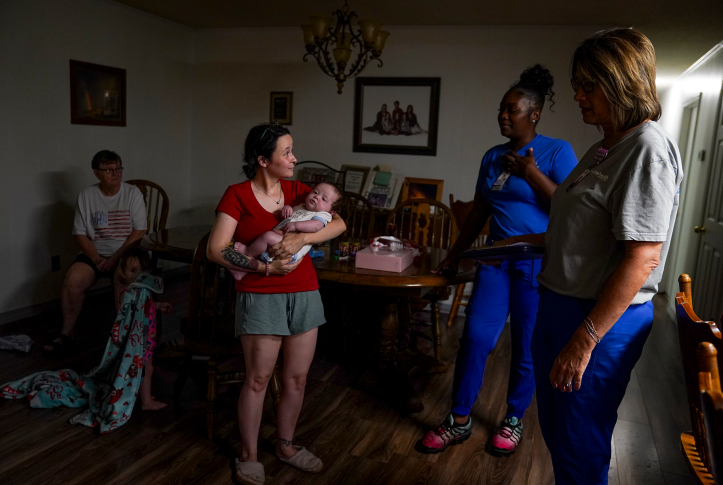Community health centers (CHCs) provide services to many underserved populations and communities, including low-income families, communities of color, rural residents, and people living in maternity care deserts.
However, after the Supreme Court’s decision in Dobbs v. Jackson Women’s Health Organization, CHCs have faced accumulating stressors. Among these are an increased demand for contraception and maternity care, a deepening ob-gyn workforce shortage, and hospital maternity unit closures that undermine patients’ access to comprehensive reproductive health care. Based on a series of focus groups with CHCs in abortion-ban states across the country, this blog post describes challenges and barriers affecting patients.
Access to Maternity Services Is Threatened by Workforce Challenges and Legal Restrictions
Within abortion-ban states, three factors are limiting maternity patients’ access to services:
- CHC patients may be unable to access timely prenatal care as demand increases and the workforce shrinks. Health centers in abortion-ban states report that they have few or no ob-gyns, and anticipate continued recruitment challenges as providers increasingly leave these states. In rural areas, the problem is generally more severe as hospitals close or shutter their birthing units due to costs and provider shortages. These factors could deeply impact patient access to timely prenatal and maternity care.
- Many people who need pregnancy terminations cannot travel to access care, forcing them to continue life-threatening pregnancies. Following the cascade of state abortion bans in recent years, CHCs report that travel to “non-ban” states is too far and too expensive for many patients. When a six-week abortion ban went into effect in Florida in May, the options for low-income patients in the southern United States became even more limited. Without other options, patients with life-threatening conditions, such as ectopic pregnancies, may be forced to continue their pregnancies.
More high-risk maternity patients are turning to CHCs, but health centers are limited in the care they can provide. With hospital maternity units closing and many specialty providers in states with abortion bans unwilling to accept high-risk maternity cases, patients are increasingly seeking care at CHCs. However, health centers may not have the resources to treat them.
Additionally, because of restrictive state policies, CHC providers in many abortion-ban states can no longer discuss pregnancy termination as an option unless there is “imminent threat” of the mother’s death. CHCs cite having to “send mothers home” with life-threatening conditions — including placental rupture, ectopic pregnancy, and cancer. In these cases, death may not be “imminent,” but a referral for termination is needed to prevent death. Patients have no options for care other than emergency departments.
CHC clinicians also report new restrictions limiting their access to mifepristone, a medication essential to managing miscarriages. Lack of access to mifepristone and inadequate miscarriage care lead to life-threatening complications, including hemorrhaging and sepsis. These concerns and restrictions mirror national findings.
Increasing Demand for Contraception and Rising Barriers
Since the Dobbs decision, CHC interviewees have consistently reported increased demand for long-acting and reversible contraception such as IUDs and implants, vasectomies, and female sterilization.
However, health center patients may no longer be able to access the full range of contraceptive methods. Contraceptive access is threatened by the departure of ob-gyns and other family planning providers from abortion-ban states; misinformation about the legality of certain forms of contraception; and the potential loss of essential Title X funding, as states reject federal program funding conditions and decline funding. Title X funding is essential to sustain many health centers’ family planning services.
Health centers in abortion-ban states also worry about future restrictions to contraceptive access. Some providers worry that their state government will “try to out-do neighboring states” by adding more restrictions on reproductive health services. These fears are not unfounded: a recent bill to protect access to contraception failed in the Senate, and Idaho — one of the most restrictive abortion-ban states — recently passed a law that forbids adolescents from accessing contraceptives without parental consent.
Policy Recommendations
We need policy responses to address escalating threats to patient access to maternity and family planning services at health centers.
1) Health center patients need timely and consistent perinatal support and care coordination. CHCs describe the need for timely, sustainable care coordination for maternity patients with medical or social risks, especially as demand for maternity care increases and the workforce shrinks. To strengthen this capacity, health centers rely on community health workers (CHWs) and doulas trained in perinatal screening, social support, and navigating the care system. While an increasing number of states invest in this care — using public health funding and Medicaid reimbursement — health center CHWs and doulas are generally funded through limited grants. States should adopt Medicaid payment arrangements for perinatal CHW staff and doula services and support workforce training.
2) Rural communities and maternity care deserts need sustainable reproductive care options. Current CHC payment models fail to support access to comprehensive reproductive health care, including the full range of contraceptive options. Notably, the current Medicaid payment model does not adequately cover the true cost of comprehensive family planning services. While some CHCs rely on Title X grants to provide these services, participating CHCs face administrative reporting burdens, uncertainty regarding future funding, and potential conflicts between Title X mandates and state law. We need adjustments to the CHC payment rates, which could include additional incentives for family planning care.
Particularly for CHCs in maternity deserts, we need a greater investment in and reimbursement for strategies to increase access and accessibility, including mobile clinics, transportation support, and telehealth. States also should consider rethinking the “bundled maternity payment,” which provides a single payment for prenatal, birth, and postpartum services. Experts suggest that bundled payments do not adequately cover the costs associated with complex pregnancies, act as disincentives to postpartum care, and have contributed to maternity unit closures.
3) CHC patients and providers need accurate communication about reproductive health options. CHCs in abortion-ban states report confusion among patients regarding their reproductive health and contraceptive options, as well as fear among women’s health providers. Federal agencies and state governments should act to reduce misinformation by developing materials for patients and providers that offer family planning guidance and maternal health options and services.
Community health centers have consistently aimed to provide high-quality, comprehensive women’s health care, often filling gaps in high-need, low-resource areas. As challenges escalate and future threats loom, we need to ensure that these centers have comprehensive support to avoid dire consequences for underserved communities.







